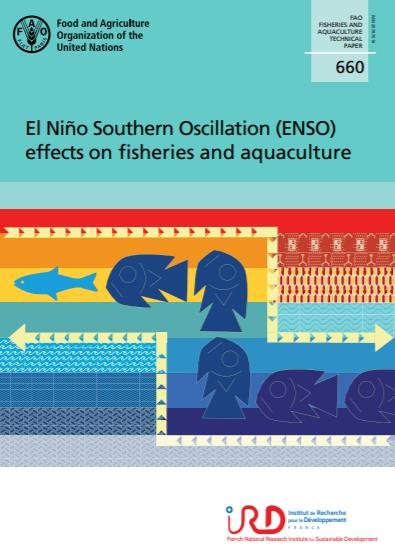- Share this article
- Subscribe to our newsletter
El Niño Southern Oscillation (ENSO) effects on fisheries and aquaculture
International experts based in Chile, France and Peru examined in a new report the impact of El Niño on fisheries and aquaculture. The report El Niño Southern Oscillation (ENSO) effects on fisheries and aquaculture was published by the Food and Agriculture Organization of the United Nations in partnership with the French National Research Institute for Sustainable Development (IRD France) in April 2020.
It captures the current state of knowledge on the impacts of ENSO events across sectors, from food security to safety at sea, from fish biology and fishing operation to management measures.
Volume changes in fish catches depend on the type of ENSO
Five broad types of ENSO were identified: Extreme El Niño, Moderate Eastern Pacific (EP) El Niño, Moderate Central Pacific (CP) El Niño, Coastal El Niño, Strong La Niña. The authors also recognise that these five types are not static. ENSO events generally worsen with the effects of climate change on fish and fisheries, but the evidence is not yet conclusive enough, they say.
For marine fisheries, the volume as well as the dominant species in fish catches can change dramatically depending on the type of ENSO. While the bulk of the net change is on Eastern Pacific fisheries, there are notable impacts on some fish populations in the Atlantic Ocean and some impact on tuna fisheries in the Indian Ocean. Further analysis of fish populations and sizes could shed light on longer-term effects as ENSO events alter habitats and marine food webs long after they are over.
ENSO events can significantly impact aquaculture output
Fostering nimble fishing techniques can contribute to resilience, as Peruvian fishers showed when they adjusted to catch more shrimp that moved into warmer waters and thus offset the missing anchoveta. At the same time, the authors note that El Niño events do not necessarily favour alternative species productivity of sardine and mackerel populations, but rather increase their susceptibility to capture - relevant information for fisheries management systems in operation.
Evidence also suggests that ENSO events can significantly impact aquaculture output, particularly for marine plants, molluscs and crustaceans, while triggering shifts to more drought-resistance species in inland fisheries in countries such as Uganda.
Currently, reasonable forecasts can be made up to six months in advance, but with very little ability to predict which (ENSO) type will occur. ENSO has important impacts on cyclonic activity, ocean conditions or precipitation. The authors conclude the report with perspectives for ENSO preparedness in a warmer world.
(FAO/ile)
Read more at FAO website and download the report El Niño Southern Oscillation (ENSO) effects on fisheries and aquaculture





Add a comment
Be the First to Comment